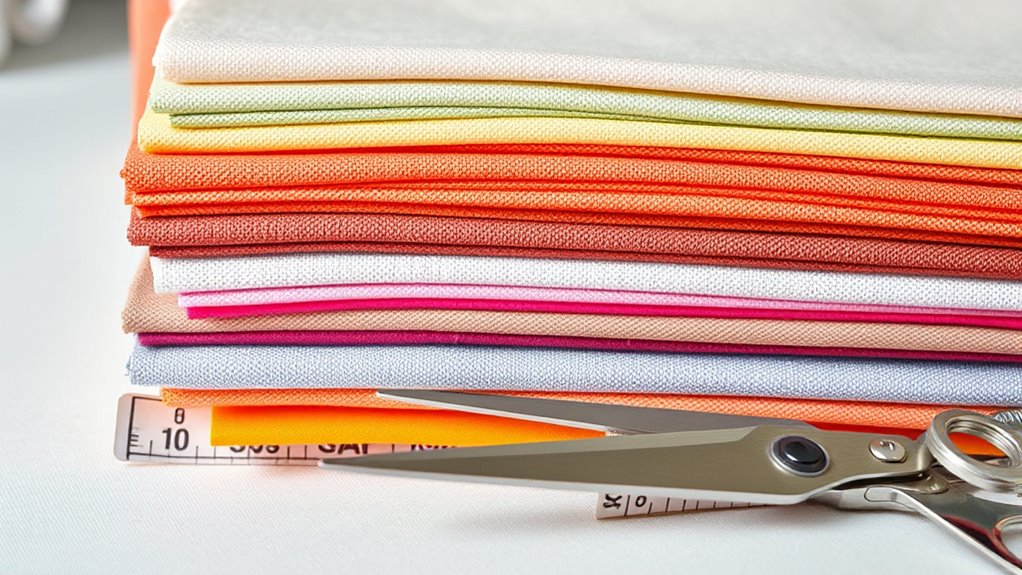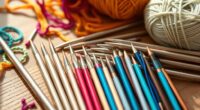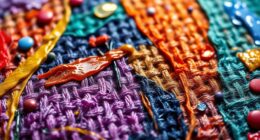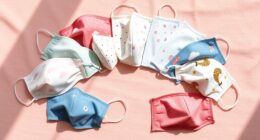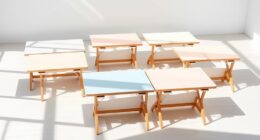When it comes to choosing fusible interfacing for shirts, I’ve found that the right option can really elevate your projects. From lightweight choices for blouses to heavy-duty options for structured designs, there’s a perfect match for every fabric type. Products like HeatnBond Ultra Lightweight and PLANTIONAL Medium Weight offer great support and ease of use. If you stick around, I’ll share insights on the best interfacing options and tips for achieving a professional finish in your sewing!
Key Takeaways
- Fusible interfacings come in various materials, including polyester, cotton blends, and weights, suitable for different fabric types and project needs.
- Proper application techniques, such as heat and pressure, are crucial for achieving secure bonding and a professional finish.
- Choose interfacings labeled as machine washable for durability, ensuring they maintain their shape and adhesion through multiple washes.
- User feedback highlights the importance of following instructions to avoid issues like misalignment or inadequate adhesion.
- Ideal uses for fusible interfacing include stabilizing collars, cuffs, and lightweight garments for added support and structure.
HeatnBond Ultra Lightweight Fusible Interfacing for Sewing
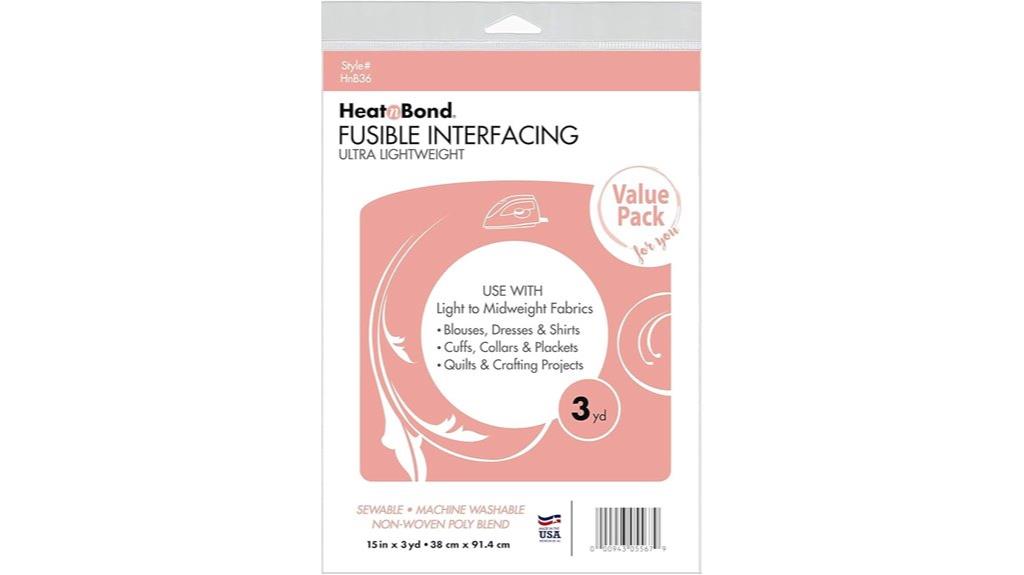
If you’re looking for an easy way to add stability to lightweight fabrics like shirts and blouses, HeatnBond Ultra Lightweight Fusible Interfacing is the perfect choice for you. This iron-on interfacing bonds effortlessly with your fabric, eliminating the hassle of basting or pinning. I’ve found it ideal for enhancing the durability of blouses and dresses while preserving their softness and drape. It minimizes shrinkage, ensuring your projects hold their shape after washing. Plus, it’s compatible with various lightweight to midweight textiles, making it a versatile addition to my sewing toolkit. Trust me, you’ll appreciate the professional finish it provides!
Best For: This product is best for sewists looking to add stability to lightweight fabrics like blouses, shirts, and dresses while maintaining their softness and drape.
Pros:
- Easy to apply with an iron, eliminating the need for basting or pinning.
- Retains fabric shape after laundering, minimizing shrinkage.
- Provides a professional finish without adding bulk or stiffness.
Cons:
- Some users reported challenges with bonding or stretching.
- May not be suitable for heavier fabrics or projects requiring more structure.
- A few users experienced issues with the initial fuse not securing properly.
ZOMONETI Light Weight White Iron On Non-Woven Fusible Interfacing

For anyone looking to add structure and stability to their shirt projects, ZOMONETI Light Weight White Iron-On Non-Woven Fusible Interfacing is an excellent choice. This high-quality polyester interfacing is lightweight, breathable, and nearly invisible on fabric, which I love. It’s perfect for collars, facings, and various garments, enhancing durability without adding bulk. The single-sided adhesive bonds easily with a hot iron, making application a breeze. Plus, it’s versatile enough for most woven fabrics. I appreciate its no-stretch nature, helping to maintain the shape of my projects. Overall, it’s a fantastic option for sewists aiming for professional results.
Best For: Those seeking a lightweight and breathable interfacing to add structure and durability to their woven fabric projects.
Pros:
- Lightweight and nearly invisible on fabric, providing a clean finish.
- Easy application with a single-sided adhesive that bonds well with a hot iron.
- Versatile and compatible with most woven fabrics, enhancing project durability.
Cons:
- Not suitable for knit fabrics unless stretch is reduced, limiting its use.
- Requires careful application to ensure proper bonding and prevent wrinkles.
- May not provide enough structure for heavier fabrics or projects needing significant support.
June Tailor T-shirt Project Fusible Interfacing , White
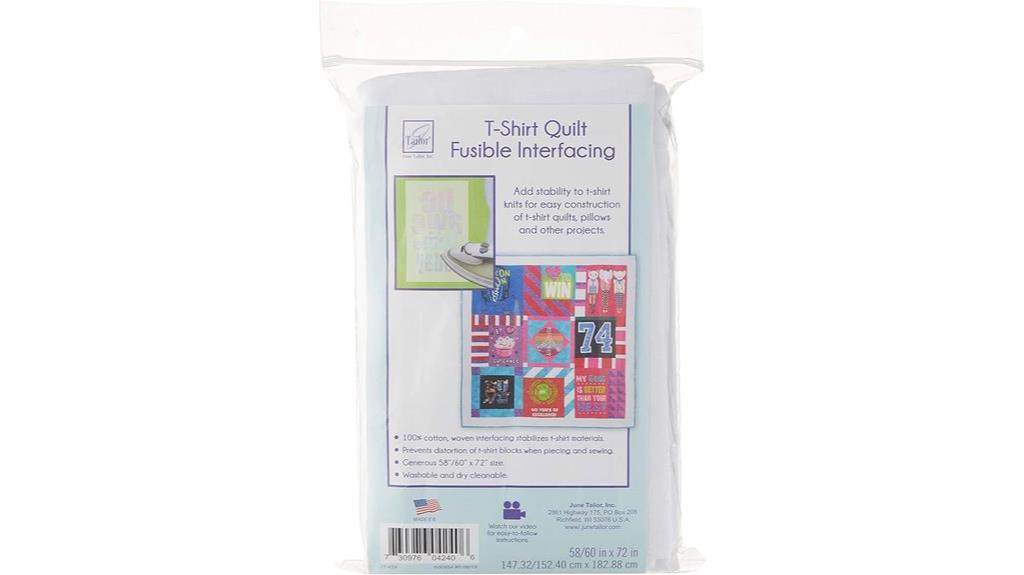
Ideal for anyone venturing into sewing with knits, the June Tailor T-shirt Project Fusible Interfacing, White, makes it easy to achieve a professional finish. This interfacing prevents distortion and adds structure, ensuring your garments look polished and well-made. I’ve found it works beautifully with both woven and knit fabrics, which opens up a world of possibilities for my projects. With generous dimensions of 58/60 inches wide by 36 inches long, it covers a lot of ground. Plus, its USA-made quality assures me of durability. If you want to elevate your sewing game, this interfacing is a fantastic choice!
Best For: Those looking to achieve a professional finish while sewing with knits and woven fabrics.
Pros:
- Prevents distortion during sewing, ensuring a polished appearance.
- Generous dimensions provide ample coverage for various projects.
- Versatile compatibility with both woven and knit fabrics enhances project possibilities.
Cons:
- May require precise application to achieve optimal results.
- Some users may find it slightly challenging to work with if new to interfacing.
- Limited to specific fabric types; may not be suitable for all materials.
PLANTIONAL Medium Weight Iron-On Non-Woven Fusible Interfacing (11.6 x 30yd)
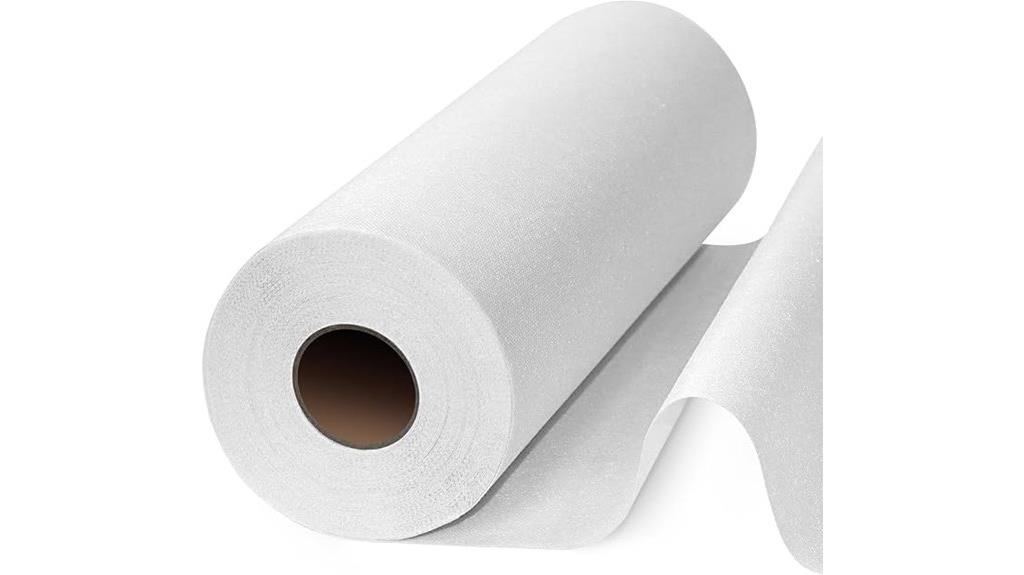
The PLANTIONAL Medium Weight Iron-On Non-Woven Fusible Interfacing is a fantastic choice for both novice and experienced sewers looking to enhance their shirt-making projects. Measuring 11.6 inches wide and 30 yards long, it offers plenty of material for various uses. Made from high-quality polyester, it provides excellent support and stability, especially for collars and cuffs. The heat-activated adhesive bonds smoothly to fabrics, ensuring a secure attachment without ripples. Plus, it holds up well after washing. I’ve found it easy to use and a staple in my sewing kit, making it perfect for any DIY project.
Best For: This product is best for both novice and experienced sewers looking to add stability and support to their sewing projects, particularly in clothing and home décor.
Pros:
- Easy to apply with heat-activated adhesive, providing a quick and secure bond to fabrics.
- Durable and maintains its shape after washing, ensuring long-term use.
- Suitable for a wide range of DIY projects, including quilting and crafts.
Cons:
- The fusible part may not stay fused if the fabric is moved excessively before sewing.
- Some users may find the adhesive less effective on certain fabric types.
- Limited to single-sided application, which may not suit all project needs.
PLANTIONAL Woven Cotton Iron-On Fusible Interfacing (10.6 inch X 10 Yards)
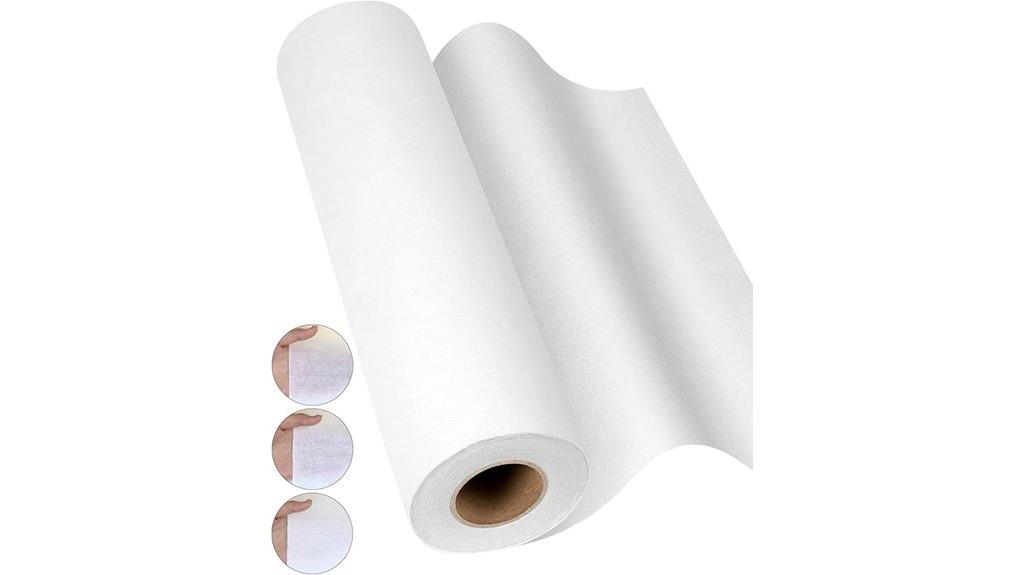
If you’re looking to enhance the durability and structure of your shirts, PLANTIONAL Woven Cotton Iron-On Fusible Interfacing is a fantastic choice. This 10.6-inch by 10-yard roll is made from 100% high-quality cotton, providing a smooth, stable foundation for various fabrics. It’s easy to apply with just an iron, which saves time and avoids mess. Plus, it’s machine washable, so you won’t have to worry about losing its bond strength after multiple washes. With options in different weights, it suits everything from delicate blouses to robust dress shirts, making it a versatile addition to your sewing toolkit.
Best For: Individuals seeking a reliable and easy-to-use interfacing option for enhancing the durability and structure of various fabric projects.
Pros:
- Easy iron-on application without mess or complex sewing.
- Machine washable, maintaining bond strength after multiple washes.
- Versatile for various fabric types and suitable for a range of sewing projects.
Cons:
- Limited to single-sided application, which may not suit all projects.
- The size may not be sufficient for larger projects without multiple rolls.
- Heavier weights may be less suitable for delicate fabrics.
Heatnbond EZ TEE Cotton Woven Iron-on Fusible Interfacing Stabilizer
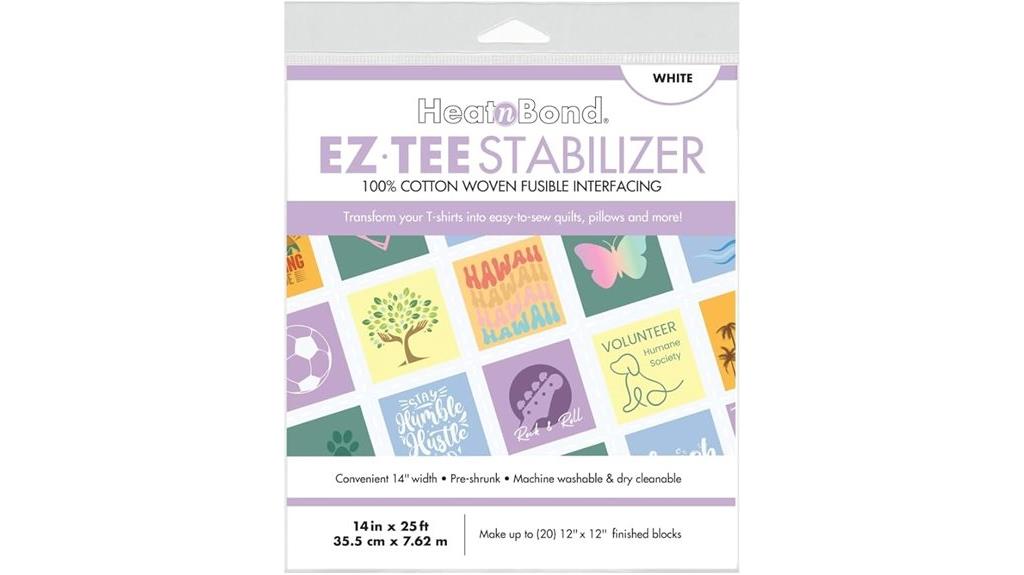
For anyone looking to create beautiful T-shirt quilts, the Heatnbond EZ TEE Cotton Woven Iron-on Fusible Interfacing Stabilizer stands out as a top choice. Measuring 14 inches by 25 feet, it’s made from 100% pre-shrunk cotton and is perfect for a variety of quilt types. I love that it’s lightweight and easy to apply, providing great stability while sewing. Plus, it’s machine washable and dry cleanable, which adds to its convenience. With an impressive average rating of 4.7 stars, this stabilizer has proven essential for achieving lovely, professional-looking quilt blocks without any hassle.
Best For: Crafters and quilters looking to stabilize T-shirts for making memory quilts, honor quilts, and other fabric projects.
Pros:
- Lightweight and easy to apply, providing stability during sewing.
- Machine washable and dry cleanable for added convenience and durability.
- High customer satisfaction with an average rating of 4.7 stars, reflecting its effectiveness in creating beautiful quilt blocks.
Cons:
- Some users reported initial packaging issues that required replacements.
- Yield may vary based on block size, potentially leading to fabric waste.
- Limited to unisex adult projects, which may not suit all quilting needs.
H.B.I. Light Weight Fusible White Non Woven Iron On Interfacing (12 x 25yd)
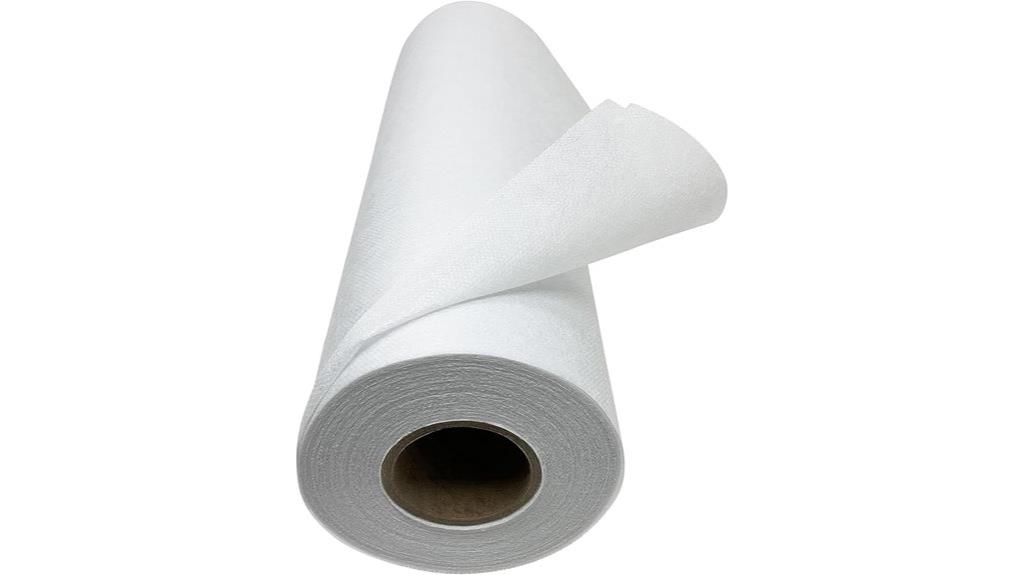
Crafted with hobbyists and professional sewists in mind, H.B.I. Light Weight Fusible White Non Woven Iron On Interfacing is my go-to choice for various projects. Measuring 12 x 25 yards, this high-quality polyester interfacing provides stability and support without adding bulk. I love the iron-on backing, making application a breeze. It’s perfect for shirt plackets, collars, and even dresses. Plus, its machine-washable feature ensures durability. With a solid 4.6-star rating, it’s clear that others appreciate its performance too. The bulk packaging is a cost-effective option, making it a smart investment for anyone passionate about sewing.
Best For: Hobbyists and professional sewists looking for a reliable, lightweight interfacing to enhance their sewing projects.
Pros:
- Easy application with iron-on backing for convenience.
- Machine washable, ensuring durability and longevity in projects.
- Cost-effective bulk packaging offers great value for extended use.
Cons:
- Limited to white color, which may not suit all fabric choices.
- Requires careful ironing to prevent wrinkles or misalignment during application.
- May not provide enough stiffness for very heavy fabrics or structured designs.
Lightweight Iron-On Fusible Interfacing for Sewing (39 x 78 inch)
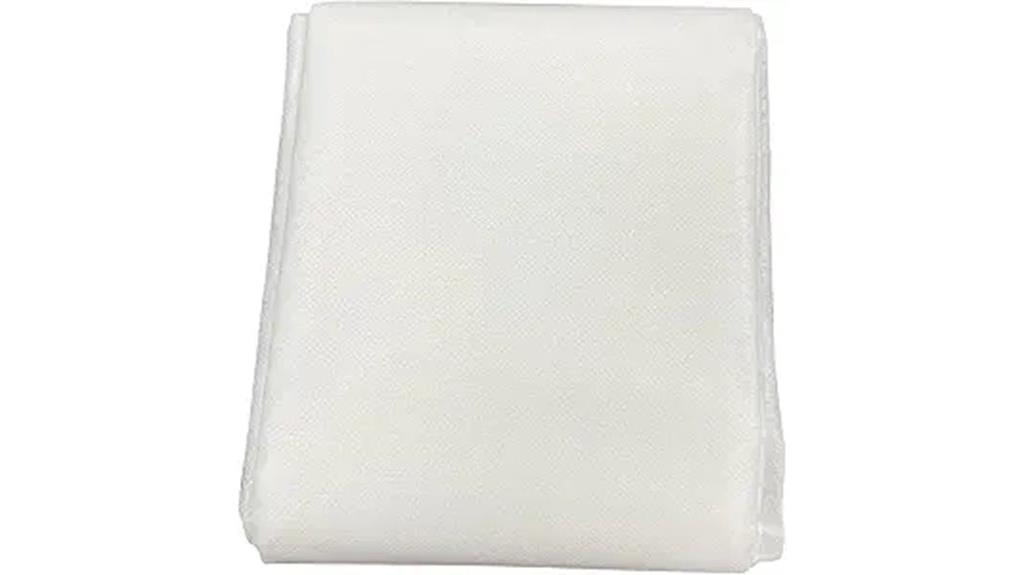
When I need a reliable solution for stabilizing fabric in my shirt-making projects, the Lightweight Iron-On Fusible Interfacing (39 x 78 inches) stands out as an ideal choice. Its single-sided, non-woven design makes it easy to work with, while the vacuum-packed folded sheet ensures it arrives wrinkle-free. I love that it’s perfect for collars, cuffs, and even quilting. Customers rave about its excellent adhesion and lightweight stability, and I’ve found it holds up well after multiple washes. Just remember to give it a thorough ironing for the best results. Overall, it’s a fantastic investment for any sewist!
Best For: This product is best for sewists and crafters looking for a reliable interfacing solution to stabilize fabrics in various sewing projects.
Pros:
- Excellent adhesion and lightweight stability for a variety of sewing applications.
- Holds up well after multiple washes, making it durable for long-term use.
- Easy to cut and work with, thanks to its single-sided design and vacuum-packed packaging.
Cons:
- Requires thorough ironing for optimal bonding, which may take longer than expected.
- Some users experienced adhesion only on one side, contrary to the expectation of double-sided fusibility.
- Not suitable for attaching fabric to fabric, limiting its use in certain projects.
PLANTIONAL Woven Cotton Iron-On Fusible Interfacing (44 inch X 2 Yards)
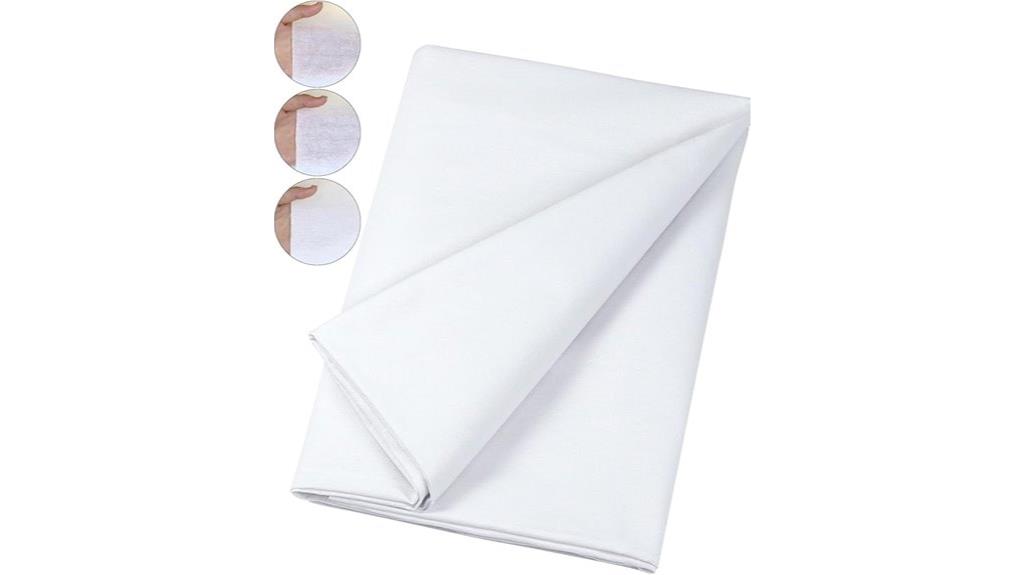
PLANTIONAL Woven Cotton Iron-On Fusible Interfacing is the perfect choice for anyone looking to enhance the quality and durability of their sewing projects. Made from 100% natural cotton, it provides a soft yet sturdy backing for all types of garments, from shirts to quilts. I love its versatility with light, medium, and heavy weights, catering to different fabric types seamlessly. The heat-activated adhesive makes application a breeze—just iron it on! With a generous width of 44 inches and 2 yards in length, it’s ideal for both small and large projects, maintaining its integrity through countless washes.
Best For: Crafters and sewing enthusiasts looking for a reliable and versatile interfacing solution for various fabric projects.
Pros:
- High-quality material: Made from 100% natural cotton, offering durability and a soft backing for garments.
- Easy application: Heat-activated adhesive allows for quick bonding with just an iron, saving time compared to sewing.
- Versatile weights: Available in light, medium, and heavy options to accommodate different fabric types and project needs.
Cons:
- Limited to iron-on: Requires an iron for application, which may not be suitable for all users or projects.
- Potential shrinkage: Some users may experience slight shrinkage after washing, depending on the fabric.
- Not suitable for all fabrics: Heavier fabrics may require additional support beyond what interfacing can provide.
Pellon SF101 Shape-Flex Cotton Woven Fusible Interfacing (20 x 10 yards)

For anyone seeking reliable support in their shirt-making projects, Pellon SF101 Shape-Flex Cotton Woven Fusible Interfacing is an ideal choice. This 100% cotton interfacing offers crisp support and stability, making it perfect for collars, cuffs, and pockets. At 20 inches wide and 10 yards long, it’s versatile for light to medium fabrics like chambray or flannel. I love how easy it is to apply, thanks to its fusible backing. Plus, it’s machine washable and can withstand gentle cycles. With a stellar 4.7-star rating, it’s no wonder sewists rave about its durability and minimal bulk. You won’t regret choosing this interfacing!
Best For: This product is best for sewists and crafters looking for a dependable interfacing to add structure and stability to garments and craft projects.
Pros:
- Easy to apply with fusible backing, saving time and effort.
- Made of 100% cotton, providing a crisp and professional finish.
- Highly rated for durability, washability, and minimal bulk in projects.
Cons:
- Limited to light to medium fabrics, which may not suit heavier projects.
- Requires careful ironing to prevent damage or misalignment.
- May not be available in all local stores, necessitating online purchase.
FIVEIZERO Medium Weight Iron-On Non-Woven Fusible Interfacing
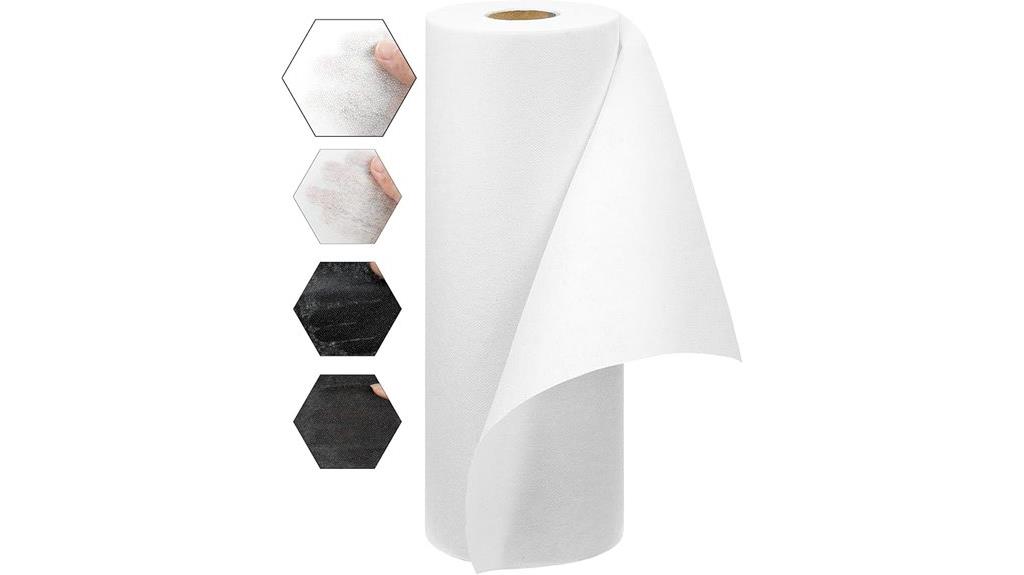
If you’re looking for a reliable option to enhance the structure of your shirts, FIVEIZERO Medium Weight Iron-On Non-Woven Fusible Interfacing is an excellent choice. Measuring 12 inches by 30 yards, it provides plenty of material for various projects like quilting, garments, and home decor. I appreciate its high-quality polyester composition, which guarantees durability and breathability. Applying it is simple—just use a hot iron with a cotton cloth to avoid direct heat. This interfacing adds stability and support, perfect for collars and facings, ultimately helping me achieve professional-looking results every time. It’s a must-have for any sewist!
Best For: Sewists and crafters looking to enhance the structure and stability of their fabric projects.
Pros:
- High-quality polyester composition ensures durability and breathability.
- Easy application with a hot iron, simplifying the crafting process.
- Versatile use across various projects, including quilting, garments, and home decor.
Cons:
- Requires careful handling to avoid direct heat during application.
- May not provide enough stiffness for very heavy fabrics.
- Availability may vary depending on location or store.
PLANTIONAL Iron-On Fusible Fleece Interfacing (16.5 Inches x 10 Yards)
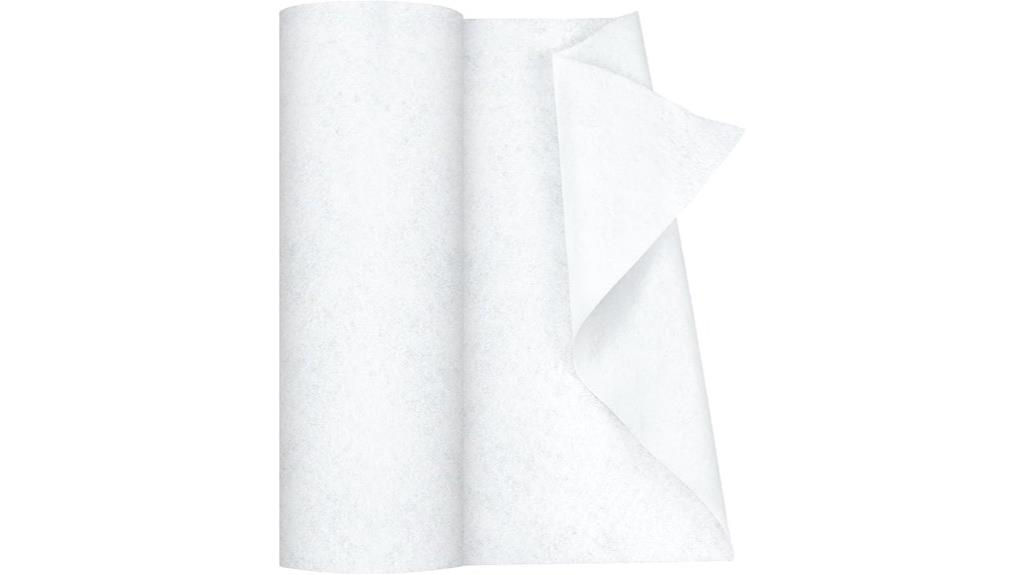
Designed with versatility in mind, the PLANTIONAL Iron-On Fusible Fleece Interfacing is perfect for anyone looking to enhance their sewing projects, whether you’re a beginner or experienced crafter. Measuring 16.5 inches wide and 10 yards long, it offers plenty of material for various projects. I love how it provides soft, cushioned support, making it ideal for everything from tote bags to placemats. The single-sided adhesive activates with heat, ensuring easy application. I appreciate its durability, holding up well after multiple washes. Plus, the professional finish it delivers is impressive. Overall, this fusible fleece is a fantastic addition to my sewing supplies!
Best For: Crafters and sewists of all skill levels looking for versatile and durable interfacing for various projects.
Pros:
- Provides soft, cushioned support, enhancing comfort and structure in finished items.
- Easy to apply with single-sided adhesive that activates with heat, ensuring a professional finish.
- Maintains its structure after multiple machine washes, offering long-lasting durability.
Cons:
- Some users expected a thicker material for certain projects.
- Lack of detailed instructions may pose a challenge for beginners.
- A few users noted the absence of varying widths in the product line.
T-Shirt Quit Project Fusible Interfacing, White (44 x 79)
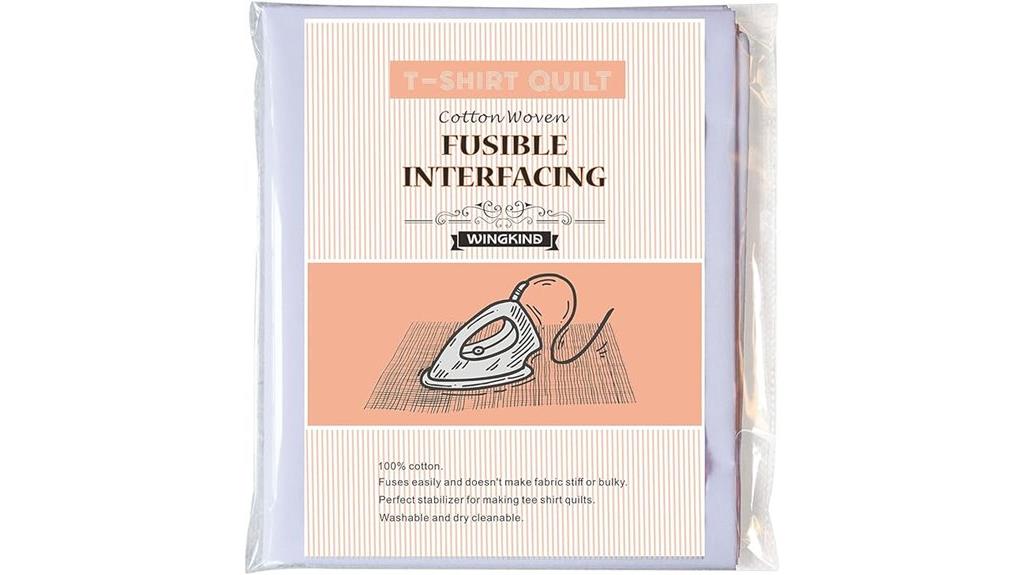
When creating a T-shirt quilt, having the right materials can make all the difference, and the WINGKIND T-Shirt Quilt Fusible Interfacing is perfect for anyone looking to stabilize stretchy fabrics. This medium-weight, 100% cotton stabilizer measures 44 x 79 inches and adheres beautifully with the right pressure while ironing. I love that it doesn’t make my fabric stiff and is washable, too. Most users rave about its effectiveness, but I recommend being patient during the ironing process. Just remember to cut it to size beforehand, and you’ll be set for a smooth quilting experience!
Best For: Quilters and crafters looking for a reliable stabilizer to work with stretchy T-shirt fabrics.
Pros:
- Easy to cut and sew, making the quilting process smoother.
- Maintains fabric flexibility without making it stiff or bulky.
- Washable and dry cleanable, ensuring durability over time.
Cons:
- Some users report issues with adherence on certain T-shirts, requiring extra effort.
- The ironing process can be time-consuming, needing patience and firm pressure.
- May be cumbersome for larger quilt projects, requiring careful management of sizes.
PLANTIONAL Medium Weight Iron-On Non-Woven Fusible Interfacing
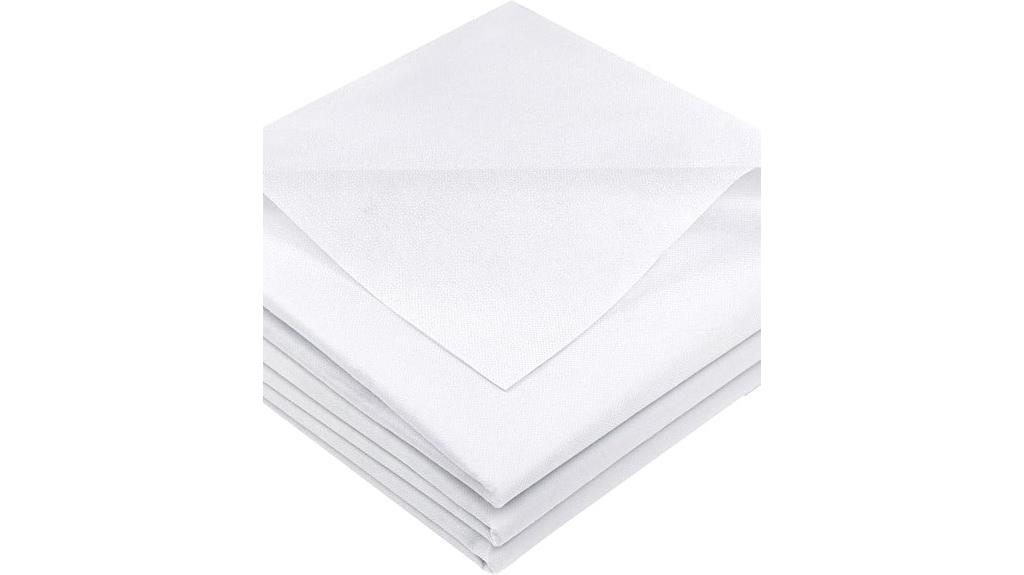
For those looking to create or enhance light to medium-weight garments, the PLANTIONAL Medium Weight Iron-On Non-Woven Fusible Interfacing is an excellent choice. Measuring 39 x 72 inches, this interfacing is perfect for various DIY projects. Its soft, non-woven texture provides support without bulk, ensuring your fabrics maintain their flow. The single-sided adhesive makes application a breeze, even for beginners. I’ve found it effectively reinforces garments, adding durability and shape. With a customer rating of 4.5 stars, it’s clearly a favorite among sewists. Plus, the generous size offers great value, allowing for multiple projects without breaking the bank.
Best For: This product is best for DIY enthusiasts and sewists looking to add support and structure to light to medium-weight fabrics in their projects.
Pros:
- Easy to use: Single-sided adhesive allows for simple and quick application with a household iron, making it suitable for all skill levels.
- Generous size: At 39 x 72 inches, it provides ample material for multiple projects, enhancing cost-effectiveness.
- High customer rating: With a rating of 4.5 out of 5 stars, it is well-received by users for its quality and performance.
Cons:
- Limited to light to medium-weight fabrics: Not suitable for heavier fabrics that may require a stronger interfacing.
- Single-sided adhesive: Some users may prefer a double-sided option for added versatility in certain projects.
- Requires heat application: Users need to have access to an iron, which may not be convenient for everyone.
STABILI-TEE Fusible Interfacing Pack 60X72 100% Polyester, Multi
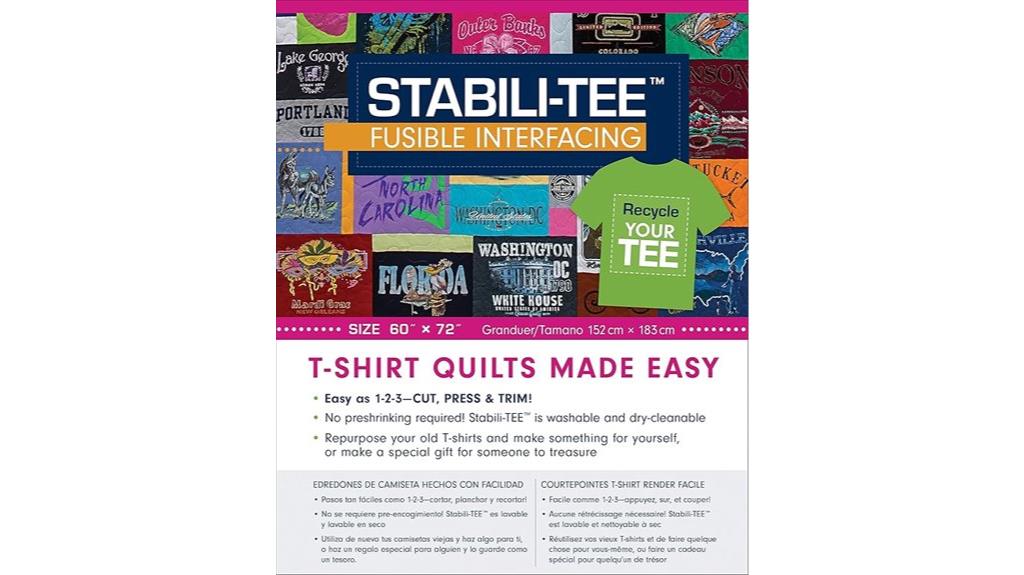
If you’re looking to elevate your sewing and craft projects, the STABILI-TEE Fusible Interfacing Pack is an excellent choice. This 60×72 inch pack, made from 100% polyester, is perfect for transforming T-shirts into memory quilts, scarves, or totes. I love the lightweight feel and 0.1mm thickness, which adds warmth without bulk. The fusible feature makes application a breeze, and the clear instructions cater to all skill levels. Plus, it’s made in the US, ensuring quality. Just remember to hand wash to keep the fabric’s integrity. With a 4.5-star rating, this interfacing is definitely worth considering!
Best For: This product is best for crafters and sewists of all skill levels looking to add structure and warmth to their projects without added bulk.
Pros:
- Fusible feature simplifies the application process, making it user-friendly.
- Lightweight and warm, offering comfort without the heaviness of traditional interfacing.
- Versatile use for various projects like memory quilts, scarves, and pillow covers.
Cons:
- Hand wash only care instructions may be inconvenient for some users.
- Limited colors available in the multicolor pack may not suit every project.
- Size may be excessive for smaller projects, leading to potential waste.
Factors to Consider When Choosing Fusible Interfacing for Shirts
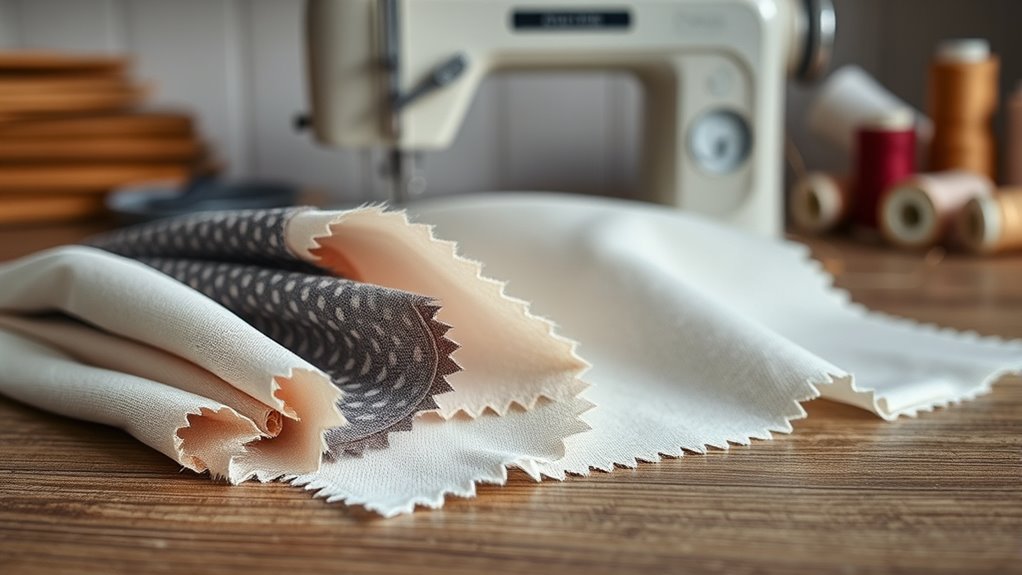
When I choose fusible interfacing for shirts, I consider several key factors to get the best results. Fabric weight compatibility, adhesive strength, and ease of application are just a few things on my list. It’s important to think about washability, durability, thickness, and softness to guarantee the finished product meets my expectations.
Fabric Weight Compatibility
Choosing the right fusible interfacing for shirts means considering fabric weight compatibility, as it directly affects the garment’s support and drape. I’ve learned that the fabric weight of your interfacing should match your shirt fabric for the best results. Lightweight interfacings work wonders for sheer or delicate fabrics, while medium to heavy-weight interfacing provides the stability needed for thicker materials. If I use a fusible interfacing that’s too heavy on lightweight fabrics, it can create stiffness, ruining the garment’s natural flow. On the flip side, lightweight interfacing on heavy fabrics won’t offer enough support, leading to an unprofessional finish. Always check the fabric weight specifications on the interfacing package to ensure compatibility, so you achieve that polished look.
Adhesive Strength and Type
After considering fabric weight compatibility, the next factor I focus on is adhesive strength and type. Fusible interfacings use heat-activated adhesives that bond the fabric when pressed with an iron, ensuring a secure attachment. I’ve noticed that the adhesive strength varies; lightweight options provide gentle support, while heavier ones offer more stability. When deciding, I consider single-sided fusible interfacing for projects needing reinforcement on one side, and double-sided options for bonding both fabrics. The quality of the adhesive is essential, influencing durability, washability, and resistance to peeling or cracking. I always make sure to follow the correct temperature, pressure, and duration during ironing; inadequate bonding can lead to peeling and loose areas in my finished shirts.
Ease of Application
While selecting fusible interfacing for shirts, I find ease of application to be a essential factor. Fusible interfacings with a smooth, single-sided adhesive are generally easier to use since they bond to just one fabric surface. I prefer interfacings that activate at lower ironing temperatures to minimize the risk of scorching delicate fabrics, which simplifies my process. Clear instructions and pre-cut sizes are also helpful, ensuring proper placement and reducing adjustments. I love when interfacings bond without steam or require minimal heat, making everything quicker and more straightforward. Finally, interfacings that adhere firmly on the first pass save me from multiple ironing rounds, streamlining my entire sewing experience.
Washability and Durability
When I think about fusible interfacing for shirts, washability and durability are essential factors that can’t be overlooked. I always ensure the interfacing is labeled as machine washable to maintain its adhesion after several laundry cycles. I prefer polyester-based options because they generally offer better durability compared to non-woven or natural fibers. The weight of the interfacing matters too; medium and heavy weights hold up better against frequent washing without losing shape. I also look for products that resist shrinking or stretching, which helps prevent deformation over time. Finally, I verify that the fusible side remains securely bonded after multiple washes, ensuring long-lasting support for my shirt projects.
Thickness and Softness
Choosing the right thickness and softness of fusible interfacing can considerably impact the feel and structure of a shirt. I’ve found that lighter fusible interfacings, like ultra lightweight options, offer a soft touch and minimal bulk, making them perfect for delicate fabrics or casual designs. On the other hand, if you opt for heavier interfacing, it adds structure and stiffness, which can sometimes hinder the shirt’s drape and comfort. It’s essential to strike a balance; too stiff can lead to discomfort, while too light may not provide enough support. Also, remember that how well you bond the interfacing affects its softness. A properly fused layer keeps things smooth and pliable, ensuring a comfortable wear.
Project Specific Requirements
Understanding the specific requirements of your shirt project is essential for selecting the right fusible interfacing. Different shirts need varying levels of support; lightweight interfacing is perfect for drape, while medium to heavy weights provide structure and stability. Think about how you’ll use the shirt—whether it’s for casual wear or a more tailored look—as this influences the stiffness and flexibility needed. Pay attention to your fabric type; woven, knit, or non-woven materials affect compatibility and adhesion. If you’re working with delicate fabrics, you’ll want minimal bulk, whereas sturdier materials may benefit from additional support. Finally, consider the desired finish, as this will guide you in choosing interfacing with the right weight and texture for your project.
Frequently Asked Questions
Can Fusible Interfacing Be Reused After Washing?
I’ve found that fusible interfacing generally can’t be reused after washing. The heat and adhesive properties tend to break down, making it lose its stickiness. After a wash, I always check the interfacing’s integrity. If it’s still holding up, I might consider using it again for a less critical project, but I usually prefer fresh interfacing for the best results. It’s just not worth the risk of it failing later on.
How Do I Properly Store Leftover Interfacing?
I store my leftover interfacing by rolling it up neatly and placing it in a plastic bin. I make sure to keep it away from direct sunlight to prevent any damage. I also label each type of interfacing for easy identification later. If it’s already cut, I’ll keep it flat between sheets of tissue paper to avoid creasing. This way, everything stays organized and ready for my next sewing project!
Is There a Difference Between Woven and Non-Woven Interfacing?
Yes, there’s definitely a difference between woven and non-woven interfacing! I’ve found that woven interfacing has a grain, which gives it more structure and stability. It behaves more like fabric, making it great for tailored garments. On the other hand, non-woven interfacing is more flexible and easier to cut, but it lacks that grain. I usually choose based on the project’s needs, and both have their unique advantages.
Can I Use Fusible Interfacing for Knit Fabrics?
Yes, you can use fusible interfacing for knit fabrics, but I recommend choosing the right type. I’ve found that lightweight, stretchy fusible interfacing works best, as it moves with the fabric and doesn’t cause unwanted stiffness. When I applied it, I noticed improved stability without compromising the knit’s natural drape. Just be sure to test it on a scrap piece first, ensuring it adheres well and maintains the fabric’s flexibility.
What Is the Best Way to Remove Fusible Interfacing?
To remove fusible interfacing, I first steam it with a hot iron, gently lifting the fabric. Then, I peel it away carefully, making sure not to damage the garment. If it’s stubborn, I dampen the interfacing with water and try again. I’ve found patience is key—taking my time prevents tearing. finally, I always check for any residue, ensuring my fabric is clean and ready for the next step.
Conclusion
Choosing the right fusible interfacing for your shirts can feel like finding a needle in a haystack, but it’s worth the effort. With options ranging from ultra-lightweight to medium weight, there’s something for every project. Remember to contemplate fabric type and desired stiffness. Whether you’re a seasoned sewist or just starting out, the right interfacing can elevate your sewing game and help your creations shine. Happy sewing, and may your shirts be as fabulous as you!

